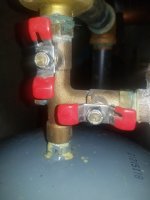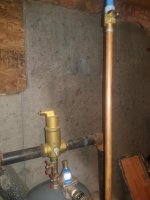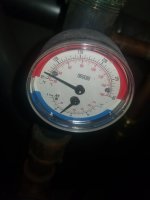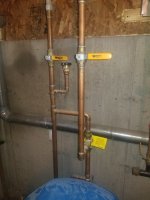It's not sucking in air- higher pressure water on the potable side is seeping into the heating system water through leaks in the internal heat exchanger.
The water heater is toast, done, gone.
If the only thing you're using the boiler for most the time is hot water you're probably better off putting the replacement money into a
heat pump water heater. The average efficiency of the boiler when it's only heating hot water is pretty crummy- less than 60%. See the "Summer domestic hot water efficiency (%)" column in
Table 2 of this document.
At an optimistic 60% efficiency the 138,500 BTU/gallon source fuel energy of heating oil is only putting (0.60 x 138,500=) 83,000 BTU/gallon into the water heater- the rest is standby & distribution loss. So per million BTU (MMBTU) that's taking 1,000,000/83,000= 12 gallons per MMBTU. At
$3/gallon that's costing $36/MMBTU.
At the legal minimum EF 0.92 of a dumb electric tank every kwh is delivering (0.92 x 3412BTU/kwh=) 3139 BTU into the water- the rest is standby loss. So that's (1,000,000/3139=) 319 kwh/MMBTU. At
19 cents/kwh that's $60.61 / MMBTU. A typical EF 2.2 heat pump water heater would be costing ($60.61 x 0.92/2.2 =) $25.35/MMBTU. With a heat pump water heater with an EF of 3.0 the cost of heating water would be ($60.61 x 0.92/3.0=) $18.59/MMBTU, half the cost of heating it with the oil boiler.
If it normally takes a dehumidifier to keep the basement dry enough in summer, a heat pump water heater will be doing double-duty, taking signifant load off the dehumidifier, converting the latent heat of vaporization of the water retrieved into hot water in the tank rather than warming up the air in the basement.
The down sides to heat pump water heaters are the slow recovery rate, and they're a bit noisy (not usually a problem if installed in a basement boiler room), but some have gotten a lot quieter in the past couple of years. With more than a decade of product history, development & design tweaking for better reliability they are no longer a new-unproven technology to be avoided. A 50 gallon Rheem with an EF of 3.2 runs about $1300 at box stores, and would be adequate for most houses. There are others.
Have any big soaker tubs to fill? Do you feel a need for the "endless shower" experience? Those might be show-stoppers, but a typical 4 person mostly-showering family can usually do just fine without upsizing from there.







